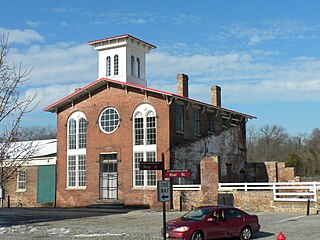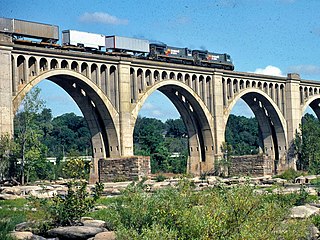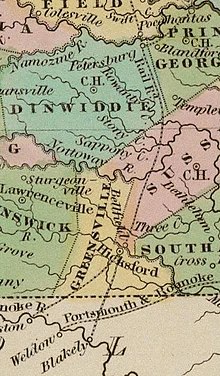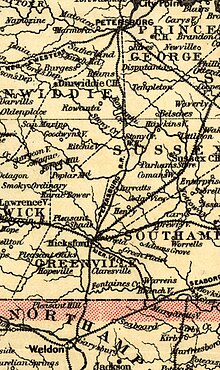
The Seaboard Coast Line Railroad was a Class I railroad company operating in the Southeastern United States beginning in 1967. Its passenger operations were taken over by Amtrak in 1971. Eventually, the railroad was merged with its affiliate lines to create the Seaboard System in 1983.

The Seaboard Air Line Railroad, which styled itself as "The Route of Courteous Service", was an American railroad that existed from April 14, 1900, until July 1, 1967, when it merged with the Atlantic Coast Line Railroad, its longtime rival, to form the Seaboard Coast Line Railroad. Predecessor railroads dated from the 1830s and reorganized extensively to rebuild after the American Civil War. The company was headquartered in Norfolk, Virginia, until 1958, when its main offices were relocated to Richmond, Virginia. The Seaboard Air Line Railway Building in Norfolk's historic Freemason District still stands and has been converted into apartments.

The Atlantic Coast Line Railroad was a United States Class I railroad formed in 1900, though predecessor railroads had used the ACL brand since 1871. In 1967, it merged with long-time rival Seaboard Air Line Railroad to form the Seaboard Coast Line Railroad. Much of the original ACL network has been part of CSX Transportation since 1986.

The Southside Railroad was formed in Virginia in 1846. Construction was begun in 1849 and completed in 1854. The 5 ft gauge railroad connected City Point, a port on the James River with the farm country south and west of Petersburg, Virginia, to Lynchburg, Virginia, a distance of about 132 miles (212 km).

Transportation in Richmond, Virginia and its immediate surroundings include land, sea and air modes. This article includes the independent city and portions of the contiguous counties of Henrico and Chesterfield. While almost all of Henrico County would be considered part of the Richmond area, southern and eastern portions of Chesterfield adjoin the three smaller independent cities of Petersburg, Hopewell, and Colonial Heights, collectively commonly called the Tri-Cities area. A largely rural section of southwestern Chesterfield may be considered not a portion of either suburban area.
The Wilmington and Weldon Railroad (W&W) name began use in 1855, having been originally chartered as the Wilmington and Raleigh Railroad in 1834. When it opened in 1840, the line was the longest railroad in the world with 161.5 miles (259.9 km) of track. It was constructed in 4 ft 8 in gauge. At its terminus in Weldon, North Carolina, it connected with the Seaboard and Roanoke Railroad and the Petersburg Railroad. The railroad also gave rise to the city of Goldsboro, North Carolina, the midpoint of the W&W RR and the railroad intersection with the North Carolina Railroad.
The Seaboard and Roanoke Railroad was organized in 1833 to extend from the area of the rapids of the Roanoke River at its fall line near Weldon, North Carolina to Portsmouth, Virginia, across the Elizabeth River from Norfolk on the harbor of Hampton Roads.
The Richmond and Petersburg Railroad moved passengers and goods between Richmond and Petersburg from 1838 to 1898. It survived the American Civil War and eventually merged into the Atlantic Coast Line Railroad in 1900.

The CSX A-Line Bridge is a double-track concrete bridge that carries the North End Subdivision of CSX Transportation over the James River in Richmond, Virginia. The bridge was built jointly by the Atlantic Coast Line Railroad and Richmond, Fredericksburg and Potomac Railroad in 1919. Designed by John E. Greiner, this bridge was one of many he drew up for the RF&P, and brought early success to his recently established private consulting business. The purpose of this "million dollar bridge" was to create a quicker, more direct route around Richmond by passing over east–west tracks on both sides of the river.

The Richmond and Petersburg Railroad Bridge was a bridge that carried the Richmond and Petersburg Railroad and several later railroads including the Atlantic Coast Line Railroad and the Seaboard Coast Line Railroad over the James River in Richmond, Virginia. It was first built in 1838 and after going through four different bridges was finally torn down in 1970.
The Raleigh and Gaston Railroad was a Raleigh, North Carolina, based railroad opened in April 1840 between Raleigh and the town of Gaston, North Carolina, on the Roanoke River. It was North Carolina's second railroad. The length was 100 miles (160 km) and built with 4 ft 8 in gauge. Part of the Raleigh and Gaston's tracks remains in service today as part of CSX's S Line as the Norlina Subdivision of CSX's Florence Division.

Norfolk Terminal Station was a railroad union station located in Norfolk, Virginia, which served passenger trains and provided offices for the Norfolk and Western Railway, the original Norfolk Southern Railway and the Virginian Railway. The N&W, Norfolk Southern, and Virginian's Norfolk terminal location stood in contrast to competitor railroads, such as the Chesapeake & Ohio Railroad, Southern Railway, Atlantic Coast Line Railroad, Pennsylvania Railroad and Seaboard Air Line Railroad which operated out of Cape Charles (Virginia), Newport News and Portsmouth, terminals outside of Norfolk. Customers took ferries or, later in the 20th century, buses from Norfolk to reach those other terminals. The terminal was located at 1200 East Main Street in Norfolk, near today's Harbor Park baseball stadium.
The Raleigh and Augusta Air Line Railroad was a North Carolina railroad that operated in the second half of the 19th century.

The North End Subdivision is a railroad line owned by CSX Transportation in Virginia and North Carolina. The line runs from Richmond, Virginia, to Rocky Mount, North Carolina, for a total of 123.2 miles. At its north end the line continues south from the Richmond Terminal Subdivision and at its south end the line continues south as the South End Subdivision. The North End Subdivision is the northernmost segment of CSX's A Line which in its entirety runs from Richmond to Tampa, Florida. Some of the line's notable features include running in the median of Interstate 195 in Richmond as well as the line's tall arch bridge over the James River.
The Norlina Subdivision is a railroad line owned by CSX Transportation in the U.S. State of North Carolina. The line currently runs from Norlina, North Carolina, to Raleigh, North Carolina, for a total of 51.2 miles. At its north end the line comes to an end and at its south end the line continues north from the Aberdeen Subdivision. While the current line dates back to 1840, it has been known as the Norlina Subdivision since the 1970s. Under CSX's predecessor, the Seaboard Coast Line Railroad, the Norlina Subdivision continued north to Collier Yard near Petersburg, Virginia.
The Portsmouth Subdivision is a railroad line owned by CSX Transportation in Virginia and North Carolina. The line connects CSX's network with the port city of Portsmouth, Virginia. The Portsmouth Subdivision was historically operated by the Seaboard Air Line Railroad, a CSX predecessor.
The Richmond, Petersburg and Carolina Railroad was a railroad built in the early 1900s. As its name suggests, it ran from Richmond, Virginia south through Petersburg into northern North Carolina. It was a key part of the network of the Seaboard Air Line Railroad.

The Atlantic Coast Line Railroad’s Main Line was the backbone of the Atlantic Coast Line Railroad's network in the southeastern United States. The main line ran from Richmond, Virginia to Port Tampa just southwest of Tampa, Florida, a distance of nearly 900 miles. Along its route it passed through Petersburg, Rocky Mount, Florence, Charleston, Savannah, Jacksonville, and Orlando. With the exception of a short 61-mile segment in Greater Orlando, the entire line is still owned by the Atlantic Coast Line's successor, CSX Transportation, and is still in service as their A Line.
The Seaboard Air Line Railroad’s Main Line was the backbone of the Seaboard Air Line Railroad's network in the southeastern United States. The main line ran from Richmond, Virginia to Tampa, Florida, a distance of over 800 miles. Along its route it passed through Petersburg, Raleigh, Columbia, Savannah, Jacksonville, and Ocala, Florida. While some segments of the line have been abandoned as of 2023, most of the line is still in service and is owned by the Seaboard Air Line's successor, CSX Transportation as their S-Line.
The Atlantic Coast Line Railroad's Norfolk—Rocky Mount Line was one of the company's secondary main lines running from the company's main line in Rocky Mount, North Carolina northeast to a point just outside of Norfolk, Virginia. Despite its name, it terminated at Pinners Point in Portsmouth, Virginia. Bus and ferry service connected passengers to Norfolk.













